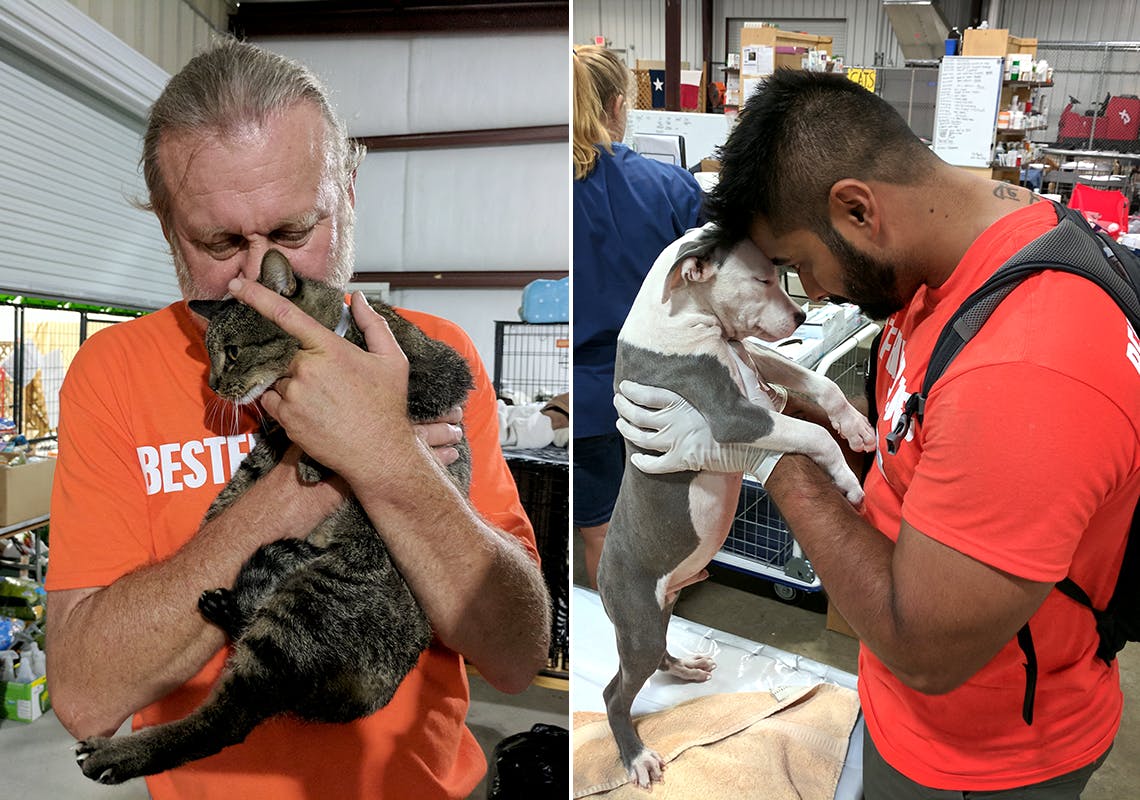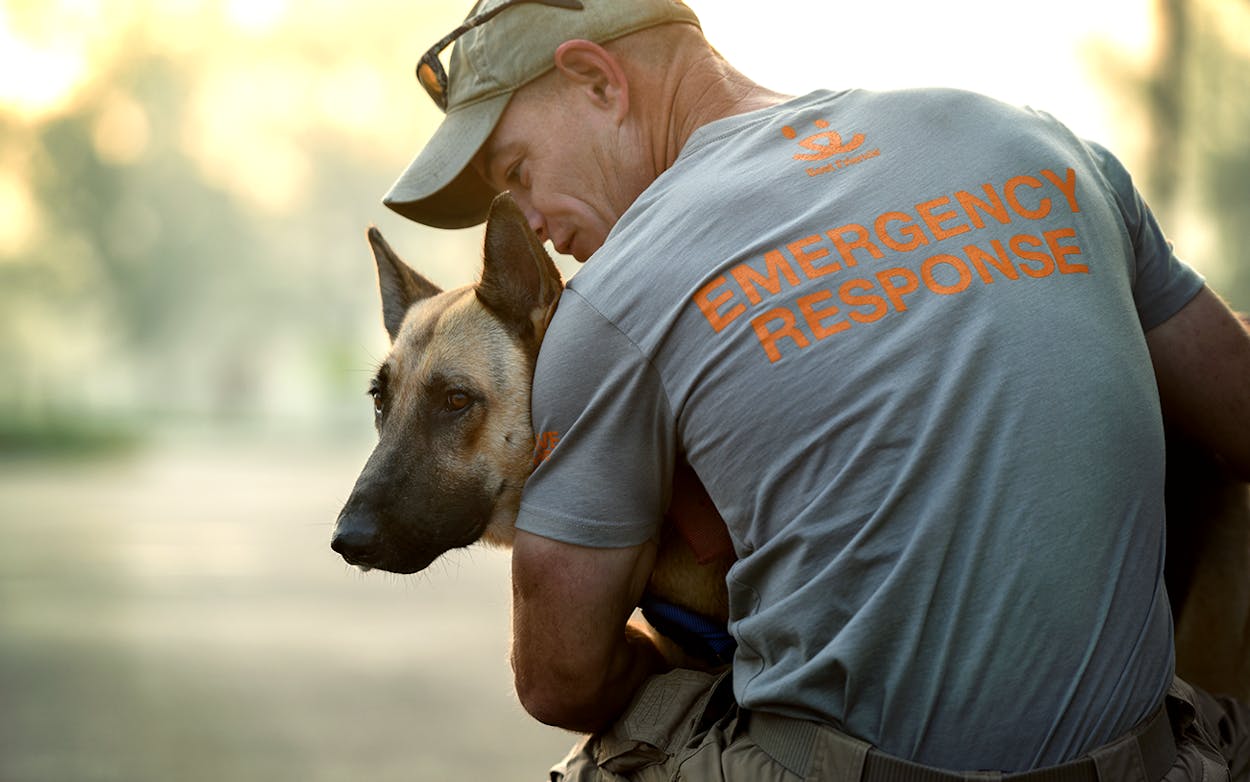One of the most heartbreaking movies ever made is the 2009 documentary Mine. The film is about rescued pets who, in the wake of Hurricane Katrina, were shipped off to other parts of the country and adopted out to loving families eager to do their part to help. The problem, of course, is that many of the animals who were re-homed already had loving families who were in the path of the storm.
As Hurricane Harvey approached the Texas coast, the organizations preparing to deal with the pets and animals in need found the lessons learned post-Katrina instructive.
There are a few best practices that became understood in the wake of Katrina: holding animals in the local area for much longer than in the past, ensuring that evacuees had opportunities to find their animals quickly, and sending animals that the organizations were confident were unowned to facilities where they could be adopted effectively. All of that came to bear in the wake of Harvey. “At the Montgomery County Animal Shelter, the warehouse set up as a staging area for bringing in these animals is right next to a Red Cross shelter,” explains Barbara Williamson of Best Friends Animal Society. “There are animals there that are somebody’s pets, and they can come and visit their pets. Post-Hurricane Katrina, if you were to talk to anybody in state disaster response in any state, that’s a priority. The recognition that pets are members of the family, and sometimes they’re the only thing people have left. They got out with their kids and their pets, and the last thing you want is for them to lose that four-footed family member.”
Also crucial is ensuring that families and their pets don’t get separated in the first place. Not all shelters for human evacuees are equipped to take care of pets, which is something that Austin Pets Alive—which found itself spearheading many of the animal-based relief operations around Harvey—stepped in to help with.
Mary Heerwald of Austin Pets Alive said that her organization didn’t know exactly what to expect when they got to Houston a few days after Harvey hit. They had expectations of how they’d be useful, but they quickly learned that the city’s needs were different from what they had imagined. “When we made it down to Houston, we didn’t know what we were walking into. We came with motorized canoes and boats and thought that we’d need to literally rescue animals from the water,” she says. “What we quickly found out was that no one has stepped up yet to figure out what to do with the pets who were being rescued. Once you remove a cat from the top of a car or a dog from a flooding backyard, then what do you do? They still need a chance to live and either find their family, or a safe and happy adoptive home. So we became the accidental spearheads of the pet lifesaving initiative in relation to Hurricane Harvey.”

To facilitate that, Austin Pets Alive helped set up shelters in both Houston and Austin that could take care of people and their animals at the same time. “The main evacuation shelter for Houston, we were able to help supply them with pet products and supplies—cages, crates, food—so they were able to welcome family with pets. That also happened in Austin for any evacuees who came with pets,” she says. Families who got stuck in quick-flooding situations and who had to split up from their animals as they left, they partnered with Best Friends to find places for animals to stay without worry of being separated. “We’ve had boarding facilities around Harris County open their doors for free boarding for people who’ve been displaced and need to find a place for their pets in the short-term, but they’re not surrendering them.”
Part of the best practices in a disaster situation like Harvey these days involves ensuring that shelters in the immediate area aren’t already at capacity when the storm hits. Austin Pets Alive helped local shelters on the coast evacuate animals before the storm to their facilities in Austin, and Best Friends coordinated with rescue organizations around the country to make space so that the lost and stray pets could be the focus in shelters following the storm.
“There was a veritable army of local animal rescue groups across the country coming down to move shelter animals out of the Houston area so that we can accommodate rescue animals after the hurricane,” Williamson says. “So animals in our care are going to stay for up to thirty days. That’s one of the things we really want to emphasize for people, that one of the greatest ways you can help is to adopt or foster a dog or a cat that’s in your local shelter, and that’ll make space for these animals being brought up by the groups.”
The distinction between an unowned animal and a lost or stray pet is important. Heerwald says that Austin Pets Alive has very specific criteria for determining which group an animal falls into. “What we consider an unowned animal is a pet that came to us from a shelter, or that was confirmed to have been owner surrendered. Those are the only animals we would attempt to adopt into a forever home,” she says. At the organization’s central hub in Katy, they collected as much information as possible on all incoming animals to identify if they should expect an owner to come looking—checking for microchips, marking down which animals came in wearing collars, and reaching out to owners when possible.
All of which has helped bridge the gap between Austin Pets Alive’s original mission—providing a safe place for pets who were at risk of being euthanized until they could be adopted—and the role the organization found itself taking on in the wake of Harvey.
“The animals that we deal with on a regular basis are the truly orphaned, truly homeless animals. The ones who never had a family, or were given up by their family for whatever reason,” Heerwald explains. “Now, we’re seeing these pets who are coming to our facilities, sometimes in the middle of the night, or in the middle of a hot, hot day. They don’t know what’s happening, or you can’t explain to them why they’ve been through what they’ve been through. They’re scared, and they’re tired, and they’re confused, and we’re able to bring them to Austin and put them into a loving and warm foster home.”








